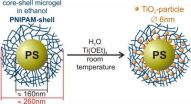(Press-News.org) An international team of scientists has discovered how an important natural antibiotic called dermcidin, produced by our skin when we sweat, is a highly efficient tool to fight tuberculosis germs and other dangerous bugs.
Their results could contribute to the development of new antibiotics that control multi-resistant bacteria.
Scientists have uncovered the atomic structure of the compound, enabling them to pinpoint for the first time what makes dermcidin such an efficient weapon in the battle against dangerous bugs.
Although about 1700 types of these natural antibiotics are known to exist, scientists did not until now have a detailed understanding of how they work.
The study, carried out by researchers from the University of Edinburgh and from Goettingen, Tuebingen and Strasbourg, is published in Proceedings of the National Academy of Sciences.
Sweat spreads highly efficient antibiotics on to our skin, which protect us from dangerous bugs. If our skin becomes injured by a small cut, a scratch, or the sting of a mosquito, antibiotic agents secreted in sweat glands, such as dermcidin, rapidly and efficiently kill invaders.
These natural substances, known as antimicrobial peptides (AMPs), are more effective in the long term than traditional antibiotics, because germs are not capable of quickly developing resistance against them.
The antimicrobials can attack the bugs' Achilles' heel – their cell wall, which cannot be modified quickly to resist attack. Because of this, AMPs have great potential to form a new generation of antibiotics.
Scientists have known for some time that dermcidin is activated in salty, slightly acidic sweat. The molecule then forms tiny channels perforating the cell membrane of bugs, which are stabilised by charged particles of zinc present in sweat. As a consequence, water and charged particles flow uncontrollably across the membrane, eventually killing the harmful microbes.
Through a combination of techniques, scientists were able to determine the atomic structure of the molecular channel. They found that it is unusually long, permeable and adaptable, and so represents a new class of membrane protein.
The team also discovered that dermcidin can adapt to extremely variable types of membrane. Scientists say this could explain why active dermcidin is such an efficient broad-spectrum antibiotic, able to fend off bacteria and fungi at the same time.
The compound is active against many well-known pathogens such as tuberculosis, Mycobacterium tuberculosis, or Staphylococcus aureus. Multi-resistant strains of Staphylococcus aureus, in particular, have become an increasing threat for hospital patients. They are insensitive towards conventional antibiotics and so are difficult to treat. Staphylococcus aureus infections can lead to life-threatening diseases such as sepsis and pneumonia. The international team of scientists hopes that their results can contribute to the development of a new class of antibiotics that is able to attack such dangerous germs.
Dr Ulrich Zachariae of the University of Edinburgh's School of Physics, who took part in the study, said: "Antibiotics are not only available on prescription. Our own bodies produce efficient substances to fend off bacteria, fungi and viruses. Now that we know in detail how these natural antibiotics work, we can use this to help develop infection-fighting drugs that are more effective than conventional antibiotics."
### END
Scientists unveil secrets of important natural antibiotic
2013-02-21
ELSE PRESS RELEASES FROM THIS DATE:
In rich and poor nations, giving makes people feel better than getting, research finds
2013-02-21
WASHINGTON - Feeling good about spending money on someone else rather than for personal benefit may be a universal response among people in both impoverished countries and rich nations, according to new research published by the American Psychological Association.
"Our findings suggest that the psychological reward experienced from helping others may be deeply ingrained in human nature, emerging in diverse cultural and economic contexts," said lead author Lara Aknin, PhD, of Simon Fraser University in Canada.
The findings provide the first empirical evidence that "the ...
Cell therapy a little more concrete thanks to VIB research
2013-02-21
Cell therapy is a promising alternative to tissue and organ transplantation for diseases that are caused by death or poor functioning of cells. Considering the ethical discussions surrounding human embryonic stem cells, a lot is expected of the so-called 'induced pluripotent stem cells' (iPS cells). However, before this technique can be applied effectively, a lot of research is required into the safety and efficacy of such iPS cells. VIB scientists associated to the UGent have developed a mouse model that can advance this research to the next step.
Lieven Haenebalcke ...
VHA plays leading role in health information technology implementation and research
2013-02-21
Philadelphia, Pa. (February 21, 2013) - The Veterans Health Administration (VHA) is aiming to become a leader in using health information technology (HIT) to change the way patients experience medical care, to decrease medical mistakes, and to improve health outcomes. A special March supplement of Medical Care highlights new research into the many and varied types of HIT projects being explored to improve the quality of patient care throughout the VHA system. Medical Care is published by Lippincott Williams & Wilkins, a part of Wolters Kluwer Health.
The special issue ...
Antibacterial protein's molecular workings revealed
2013-02-21
On the front lines of our defenses against bacteria is the protein calprotectin, which "starves" invading pathogens of metal nutrients.
Vanderbilt investigators now report new insights to the workings of calprotectin – including a detailed structural view of how it binds the metal manganese. Their findings, published online before print in the Proceedings of the National Academy of Sciences, could guide efforts to develop novel antibacterials that limit a microbe's access to metals.
The increasing resistance of bacteria to existing antibiotics poses a severe threat to ...
When water speaks
2013-02-21
Why certain catalyst materials work more efficiently when they are surrounded by water instead of a gas phase is unclear. RUB chemists have now gleamed some initial answers from computer simulations. They showed that water stabilises specific charge states on the catalyst surface. "The catalyst and the water sort of speak with each other" says Professor Dominik Marx, depicting the underlying complex charge transfer processes. His research group from the Centre for Theoretical Chemistry also calculated how to increase the efficiency of catalytic systems without water by ...
Sniffing out the side effects of radiotherapy may soon be possible
2013-02-21
Researchers at the University of Warwick and The Royal Marsden NHS Foundation Trust have completed a study that may lead to clinicians being able to more accurately predict which patients will suffer from the side effects of radiotherapy.
Gastrointestinal side effects are commonplace in radiotherapy patients and occasionally severe, yet there is no existing means of predicting which patients will suffer from them. The results of the pilot study, published in the journal Sensors, outline how the use of an electronic nose and a newer technology, FAIMS (Field Asymmetric ...
Titanium dioxide nanoreactor
2013-02-21
This press release is available in German.
Now, Dr. Katja Henzler and a team of chemists at the Helmholtz Centre Berlin have developed a synthesis to produce nanoparticles at room temperature in a polymer network. Their analysis, conducted at BESSY II, Berlin's synchrotron radiation source, has revealed the crystalline structure of the nanoparticles. This represents a major step forward in the usage of polymeric nanoreactors since, until recently, the nanoparticles had to be thoroughly heated to get them to crystallize. The last synthesis step can be spared due ...
Wanted: A life outside the workplace
2013-02-21
EAST LANSING, Mich. — A memo to employers: Just because your workers live alone doesn't mean they don't have lives beyond the office.
New research at Michigan State University suggests the growing number of workers who are single and without children have trouble finding the time or energy to participate in non-work interests, just like those with spouses and kids.
Workers struggling with work-life balance reported less satisfaction with their lives and jobs and more signs of anxiety and depression.
"People in the study repeatedly said I can take care of my job demands, ...
Research discovers gene mutation causing rare eye disease
2013-02-21
New Orleans, LA – Research conducted by Dr. Jayne S. Weiss, Professor and Chair of Ophthalmology at LSU Health Sciences Center New Orleans, and colleagues has discovered a new mutation in a gene that causes Schnyder corneal dystrophy (SCD.) The gene was found to be involved in vitamin K metabolism suggesting the possibility that vitamin K may eventually be found useful in its treatment. The findings are published in the February 2013 issue of the peer-reviewed journal, Human Mutation.
Schnyder corneal dystrophy is a rare hereditary eye disease that results in progressive ...
City layout key to predicting riots
2013-02-21
In the future police will be able to predict the spread of riots, and how they impact on cities, thanks to a new computer model.
Developed by researchers at UCL, the model highlights the importance of considering the layout of cities in order for police to suppress disorder as quickly as possible once a riot is in progress.
"As riots are rare events it is difficult to anticipate if and how they will evolve. Consequently, one of the main strategic issues that arose for the police during the 2011 London riots concerned when and where to deploy resources and how many ...

